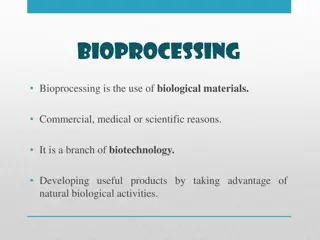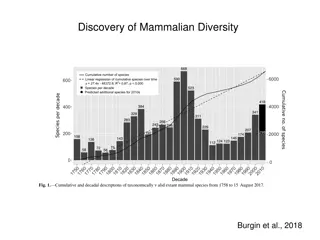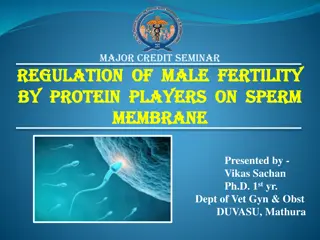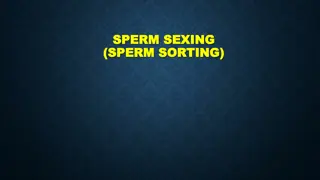Assisted Reproductive Techniques: Oocyte Retrieval Process
The process of oocyte retrieval in assisted reproductive techniques involves the careful retrieval of cumulus-oocyte complexes from follicular fluid under anesthesia and ultrasound guidance. These complexes are then sorted and stored before further procedures such as in-vitro insemination or intracy
1 views • 13 slides
Male Reproductive Tract Anatomy in Animal Science
Explore the anatomy of the male reproductive system in animals, focusing on the testis, epididymis, bull reproductive organs, and more. Learn about the functions of the testes, sperm production, testosterone, and the structures involved in sperm delivery and storage. Detailed imagery and description
7 views • 40 slides
Protein Expression Market
Protein Expression Market by System (Mammalian [CHO, HEK 293], Non-mammalian [Bacterial, Insect, Yeast]), Offering (Kits & Reagents, Vectors, Competent Cells, Services), Application (Industrial, Therapeutic, Research), and End User - Global Forecast to 2030\n\n
4 views • 4 slides
Hope for Pregnancy What You Need to Know About Blocked Fallopian Tubes
Over 30% of women suffering from Infertility have either blocked or damaged fallopian tubes. The condition of blocked fallopian tubes in the female reproductive tract is also known as tubal Infertility, tubal disease, or tubal occlusion. Unlike other Infertility disorders, blocked fallopian tubes do
9 views • 7 slides
Regulation of Energy Homeostasis by AMPK System and Its Modulation Factors
The AMPK system plays a crucial role in regulating energy homeostasis by sensing the cellular AMP:ATP ratio and responding to metabolic stresses that affect ATP production or consumption. AMPK is activated by factors such as hypoxia, glucose deprivation, and metabolic inhibitors, as well as by compo
0 views • 27 slides
Understanding Bioprocessing: Advantages, History, Applications, and Enzyme Use
Bioprocessing utilizes biological materials for commercial, medical, and scientific purposes, leveraging natural biological activities to develop useful products. This branch of biotechnology offers advantages such as low temperature, pressure, and pH requirements, along with renewable resources for
1 views • 11 slides
Understanding the Male Reproductive System Physiology
The male reproductive system facilitates spermatogenesis, hormone production, and the physiological processes essential for ejaculation and erection. Sperm cells mature in the epididymis before passing through the vas deferens to reach the seminal vesicle, where they are nourished with nutrient-rich
0 views • 11 slides
Mammalian Dentition and Tooth Structure Exploration
Understanding dentition in mammals sheds light on their evolution, classification, age approximation, and dietary habits. The arrangement of teeth, tooth structure, development, and types of mammalian teeth are discussed, highlighting unique features like thecodont attachment, enamel coating, and de
2 views • 16 slides
Male Reproductive System Overview
The male reproductive system is responsible for producing and delivering fertile sperm, as well as regulating hormones like testosterone. It includes the scrotum, testes, ducts, and accessory glands. Important functions include spermatogenesis, thermoregulation, and supporting secondary sexual chara
1 views • 22 slides
Overview of Lymphoid Organs in Finfish and Shellfish
Lymphoid organs play a crucial role in the defense mechanisms of finfish and shellfish by generating immune cells. Different types of fish vary in their lymphoid organ structures, with jawless fish relying on lymphoid tissue within other organs for immune cell production. Cyclostomes, like hagfish a
1 views • 24 slides
Understanding the Ultrastructure of Spermatozoa and Their Components
Explore the intricate details of spermatozoa and their structures, including the head, nucleus, acrosome, and more. Learn about the dimensions of mammalian spermatozoa and the principal parts that make up these essential reproductive cells.
0 views • 23 slides
Understanding Carbamate Insecticides: Classification, Mechanism of Action, Clinical Signs, and Treatment
Carbamate insecticides are widely used in agricultural and veterinary practices due to their broad-spectrum activity and low mammalian toxicity. This chapter discusses the classification, similarities with organophosphate compounds, differences, mechanism of action, clinical signs, diagnosis, and tr
1 views • 13 slides
Understanding the Composition of Milk by Dr. Sanjeev Kumar
Milk, a vital substance for mammalian offspring, is a complex fluid composed of water, fat, protein, lactose, minerals, vitamins, and enzymes. Dr. Sanjeev Kumar, an Associate Professor and Head of the Department of Dairy Technology at SGIDT, enlightens us on the various constituents of milk, market
0 views • 11 slides
Understanding Amino Acids: Qualitative Tests and Properties
Amino acids play a crucial role as building blocks of proteins and can be converted into specialized products. There are 20 common L-α-amino acids found in mammalian proteins, each with a unique structure and classification based on their side chain properties. Amino acids exhibit optical activity,
1 views • 34 slides
Understanding the Structure and Role of Amino Acids in Proteins
Amino acids are building blocks of proteins, with distinct structures and properties. There are 20 common amino acids found in mammalian proteins, each with a carboxyl group, an amino group, and a unique side chain. The side chains determine the role of an amino acid in a protein, classified as nonp
8 views • 11 slides
Understanding Semen Dynamics and Capacitation in Mammalian Spermatozoa
Semen dynamics play a crucial role in mammalian reproduction, with capacitation being a key process for sperm fertilization capability. Capacitation involves physiological changes in sperm, leading to the acrosome reaction, crucial for oocyte penetration. As sperm transit through the epididymis, the
5 views • 13 slides
Understanding the Male Reproductive System
The male reproductive system is a complex network involving gonads, ducts, and accessory glands that function to produce and transport sperm. Testes, the primary male gonads, play a crucial role in sperm production through a process called spermatogenesis. This system functions differently from the
1 views • 44 slides
Biology Week 2018 Quiz for Ages 13-15
Test your knowledge with this engaging Biology Week 2018 quiz designed for ages 13-15. The quiz includes questions on various topics such as fungi, cow anatomy, famous scientists, plant cell structures, endocrinology, atmosphere composition, mammalian reproduction, DNA similarity, animal groups, and
0 views • 22 slides
Advancements in Cell Culture Performance Optimization Through Dissecting Spent Media
The Industry/University Cooperative Research Center (I/UCRC) Advanced Mammalian Biomanufacturing Innovation Center (AMBIC) is focusing on dissecting spent media to understand the components affecting cell culture performance. The project aims to identify growth-promoting and inhibiting factors in sp
0 views • 16 slides
Understanding Cloning Vectors and Recombinant DNA Technology
Genetics Engineering Lecture-2 delves into the concept and basic steps of recombinant DNA technology and gene cloning, highlighting different types of cloning vectors like plasmids, bacteriophages, bacterial artificial chromosomes, yeast artificial chromosomes, and mammalian artificial chromosomes.
1 views • 13 slides
Immune Responses to Parasitic Infections and Evasive Strategies by Protozoan and Helminth Parasites
Parasitic infections pose complex challenges to the immune system due to the diverse nature of parasites, including protozoans and helminths. Protozoan parasites move between arthropod vectors and mammalian hosts, requiring both humoral and cell-mediated immune responses. Meanwhile, helminths, as mu
0 views • 15 slides
Sperm Cramps - Symptoms,causes, diagnosis and treatments
Sperm cramps are a post-orgasmic pain syndrome(POPS) that causes painful sensations after or during orgasm. It lasts for hours or even days. For more info visit: \/\/ \/blog\/sperm-cramps\/
1 views • 11 slides
Social Learning Among Sperm Whales and Sablefish in the Gulf of Alaska
Explore the spread of novel foraging behavior among sperm whales, depredation issues with sablefish, and the history of commercial fishing in the Gulf of Alaska. Discover insights into sperm whale sightings, the blackcod fishery, and the changing dynamics of sablefish commercial seasons.
3 views • 24 slides
Understanding Artificial Insemination and New Technologies for Fertility
Assisted Reproductive Technology (ART) offers various methods like artificial insemination using husband's semen (AIH) or donor sperm (AID), split ejaculate method, and more to help couples facing infertility. These technologies aim to address factors like male infertility, anatomical defects, and g
0 views • 33 slides
Exploring the Mammalian Diving Reflex
Delve into the fascinating adaptation of the mammalian diving reflex, where heart rate decreases when submerged in cold water to conserve body heat. Understand the evolutionary history, theory, and physiological changes involved in this reflex through an engaging experiment. Discover the sensations
0 views • 20 slides
Fascinating Discoveries in Mammalian Diversity
Recent scientific findings have unveiled new species of mammals like the gymure Podogymnura intermedia in the Philippines and chipmunks Tamias cratericus and T. grisescens. Notably, the discovery of Rice's whale highlights the critical condition of this species. The evolution and varied characterist
0 views • 28 slides
Mammalian Tooth Structure: Vertical Section Overview
Mammalian teeth consist of hard tissues (enamel, dentine, cementum) and soft tissue (tooth pulp). The enamel is the hardest, dentine surrounds the pulp cavity, and cementum covers the dentine and connects to the alveolar bone. Tooth pulp provides support, nourishment, and defense mechanisms. Support
1 views • 7 slides
Overview of Mammalian Respiratory System Histology
The respiratory system in mammals functions to warm, humidify, and cleanse the air as it travels from the nostrils to the lungs. It comprises the nasal cavity, pharynx, larynx, trachea, bronchi, and bronchial tree. The epithelial linings vary in different parts, containing specialized cells and glan
0 views • 14 slides
Understanding Male Reproductive Anatomy and Function
Explore the intricate male reproductive system from meiosis to accessory glands, learning about the purpose and location of processes like meiosis, sperm production in the testes, and the functions of structures such as the epididymis, vas deferens, urethra, and accessory glands in semen production
2 views • 23 slides
Understanding the Mammalian Diving Reflex
Explore the mammalian diving reflex, a fascinating adaptation seen in marine mammals and humans when submerged in cold water. This reflex involves a decrease in heart rate to conserve body heat, allowing for extended breath-holding. Through experiments, learn how the body reacts to underwater condit
0 views • 21 slides
Can We Be as Clever as a Sperm Whale?: Using Gizmos and Gadgets in Combatting Sperm Whale Depredation
Explore the innovative strategies employed by the Southeast Alaska Sperm Whale Avoidance Project (SEASWAP) to reduce sperm whale depredation on fishing gear in the Gulf of Alaska. Through acoustics and decoys, researchers aim to deter whales from longline hauls, ultimately protecting the marine ecos
0 views • 19 slides
Mammalian Dentition and Tooth Structure
Dentition refers to the arrangement of teeth in the upper and lower jaw of mammals. Most mammals have specialized teeth, with some exceptions like the Platypus and Baleen whales. The structure of a mammalian tooth includes the crown, root, and neck, made up of dentine, enamel, and cement. Tooth deve
0 views • 13 slides
Basics of Mammalian Cell Culture
Mammalian cell culture involves the removal of cells from an organism for growth in a controlled environment. Primary cell cultures can be sub-cultured, leading to the generation of cell lines. Sub-culturing involves transferring cells to fresh growth media for further growth. Different methods and
0 views • 29 slides
Protein Players in Male Fertility Regulation
Cooperative interactions between proteins on sperm membranes play a crucial role in male fertility regulation, affecting sperm migration, binding to the oviduct, and successful fertilization. Understanding these protein factors is essential for comprehending the complex process of mammalian fertiliz
0 views • 62 slides
Techniques and Benefits of Sperm Sexing for Livestock Breeding
Separating X and Y sperm for selective breeding allows for the production of desired male or female offspring in livestock. Various techniques such as Quinacrine Mustard Staining and Raman Micro-Spectroscopy are used to differentiate between the two sperm types based on DNA, size, surface charges, a
0 views • 16 slides
Intracytoplasmic Sperm Injection (ICSI) Procedure Overview
This detailed guide outlines the step-by-step process of performing an Intracytoplasmic Sperm Injection (ICSI) procedure, including sperm selection, oocyte injection, and fertilization confirmation. It covers essential techniques such as micromanipulation station setup, sperm immobilization, and emb
0 views • 8 slides
What is Azoospermia and How to Treat Them (Zero Sperm Count)
Azoospermia is a male infertility condition where the sperm count is zero in the semen. This blog post explains the symptoms, types, and treatments of azoospermia. For more info Visit: \/\/ \/blog\/azoospermia-symptoms-types-and-treatments\/
1 views • 10 slides
Low Sperm Count Symptoms and Solutions at Alka IVF 7 december
low sperm count symptoms
0 views • 2 slides
DNA Editing of Retrotransposons and Mammalian Genome Evolution
Large-scale DNA editing of retrotransposons plays a crucial role in accelerating mammalian genome evolution. Retrotransposons, accounting for half of the human genome, are mobile elements that can lead to mutations and genetic disorders but also serve as a reservoir for genetic innovation, rewiring
0 views • 26 slides







































